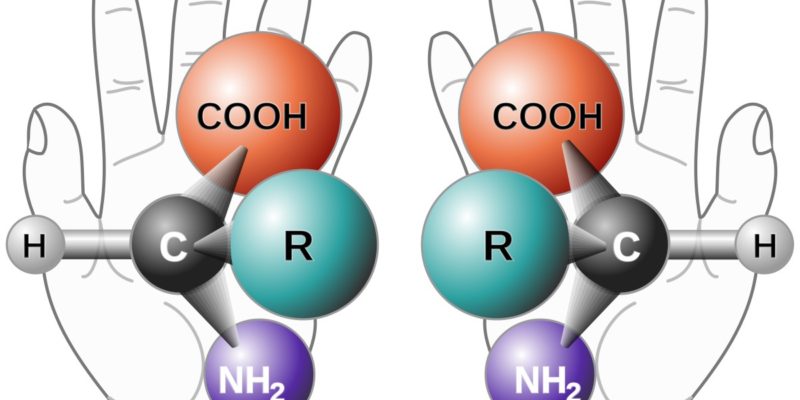Chirality has been considered one of the most important concepts of biological functions and structures. In this article, we will look into the depths of the use of Chiral carbon in the process of protein synthesis.
Proteins are made up of amino acids, but in a different form of polypeptide chains. These polypeptide chains are the foundation of the comprehensive cellular structure in any living organism. These structures help all living organisms in functioning properly. Thus making chirality an absolutely essential and critical factor to study.
What Is A Chiral Carbon?
Chiral carbon is any such central carbon atom that is attached to four components to form tetrahedron, with four components placed at for vertices of tetrahedron.
You may find many of important compounds & molecules with chirality properties, which further assists them in several functions. Some other examples are the amino acids, proteins and sugars.
Let’s take the example of Monosodium Glutamate to get a better idea.
Monosodium Glutamate MSG is the sodium salt of amino acid glutamate. It is used as a food seasoning in the food industry and is the source of umami flavor.
So, the chemical structure of MSG is c5h8nnao4 monosodium glutamate has a central carbon atom, of which,
One side attached to a carboxylic acid (COOH)
Second side attached to Amine group (NH2)
The third is the hydrogen atom (H)
And fourth is attached to the R group (C2H4COONa)
This attachment of the central carbon to the four different components makes it a chiral carbon.
What Is Protein Synthesis?
Amino acids join together to form peptide bonds in the form of chains that further combine to form the longer polypeptide chain, which we also know as proteins.
Thus, proteins are the products of amino acids, which results from the process of protein synthesis.
Let’s check out the process in detail,
Protein synthesis takes place when amino acids form polypeptide chains from their coded combinations within the cell. This requires a coded sequence, enzymes, and messenger, ribosomes and tRNAs. As is seen, the process starts in the nucleus under the supervision of DNA and RNA.
The process takes place in two steps: Translation and transcription.
Transcription is transfer of genetic instruction in DNA to mRNA in nucleus. It includes three steps: initiation, elongation, and termination. After processing the mRNA, it further carries the commands to a ribosome inside the cytoplasm. Translation happens at the ribosome, which comprises of rRNA and proteins. During the translation process, the mRNA instructions are interpreted, and tRNA brings the appropriate sequence of amino acids to the ribosome. Then, the rRNA helps in forming combinations between the amino acids, thereby producing a chain of polypeptide.
Role Of Chiral Carbon In Protein Synthesis
Every level of Protein structure has the presence of chirality, with the latter’s vital role in protein synthesis as well. The aminoacyl tRNA synthetase and ribosomes that are involved in the synthesis process have chiral components in them. This chirality is essential in the overall process to continue without any breaks.
Protein chains are composed with only L-amino acids, except glycine, making the chains homochiral. This homochirality is extremely important for the protein structure to take its form and normal cellular functions.
Before moving forward, let’s understand what homochirality is.
As you must be knowing, the chiral structure and its mirror image make them stereoisomers, L and D, to name them. Any normal chemical reaction produces L and D molecules equally.
Usually, biological molecules have similar chirality; for instance, most of the amino acids have the L forms, while most sugars have D isomers. This is the homochirality condition, which is a characteristic of almost every living organism.
This particular homochirality is required for the protein functions that depend on the molecules’ interactions with the chiral structure’s help.
For gene to encode protein with particular shape, homochirality of amino acids is required, because L- & D-amino acids will produce to different three-dimensional protein structures. Thus, the homochirality of amino acids is important for the fundamental execution of genetic control, so the chirality of molecules, including proteins, is intrinsically linked to their functions.
Besides, an enzyme usually has a chiral binding pocket or groove that fits only 1 enantiomer of substrate and not the other one. Thus, for proper molecular functions of the organisms, homochirality of biologically active molecules is an extremely critical condition.
Now coming back to our article, the cells mentioned above, taking part in the cellular functions, exclude aminoacyl-tRNA synthetases (aaRSs), elongation factor thermo-unstable (EF-Tu), and the ribosomes, to keep the D-amino acids away during the process, while only allowing L-amino acids to bind.
The importance of chirality can be found out by the mere fact of every amino acid, except glycine, having chiral carbons. These amino acids take part in the protein synthesis in their original form.
Another interesting fact about chirality is that, cells are mostly composed of chiral molecules, and hence are important with reference to chirality.
Summary
- Protein synthesis process takes place in the cells of all living things as the production of proteins is essential for all organisms in some or the other way. Amino acids combine to form a protein molecule, which is why we need the right number of amino acids too in our body, which can be consumed via your regular diet and some BCAA supplements.
- Chirality is critical for biological processes in living organisms to help them function properly.
- It is considered chiral if the item can’t be superimposed on its reflected image or mirror image. Majority of the biological molecules are chiral in nature. The homochirality of amino acids makes sure that the proteins in it are chiral, which enables the smooth critical functioning.
- Smaller chiral molecules like sugars & amino acids are the foundation of larger molecules, such as nucleic acids and proteins, which are also chiral in nature.













Comments